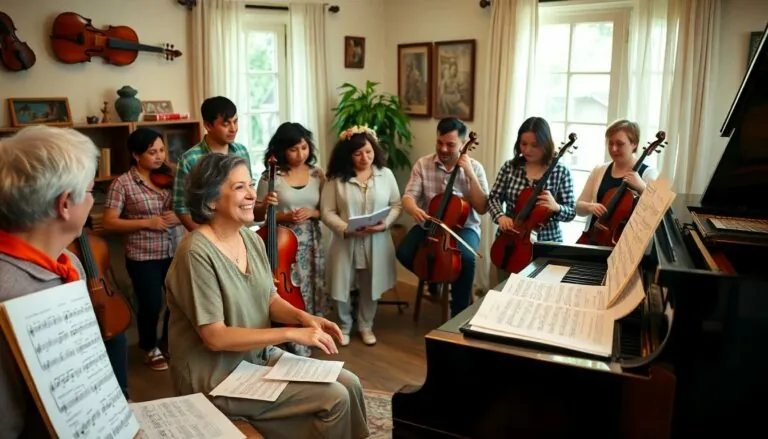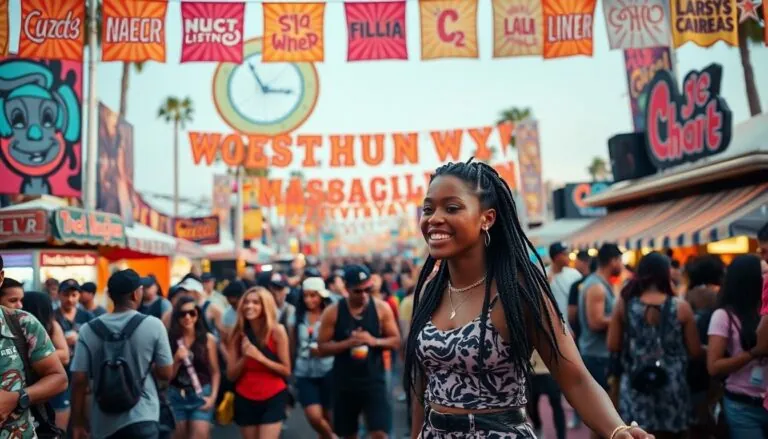Table of Contents
TogglePop music isn’t just a genre; it’s a cultural phenomenon that shapes moods, trends, and even dance moves—whether they’re good or not! From catchy hooks that stick in your head like gum on a shoe to chart-topping hits that dominate the airwaves, pop music has a unique way of connecting people. It’s the soundtrack to our lives, whether you’re belting out tunes in the shower or grooving at a party.
Overview of Pop Music
Pop music stands out as a genre that shapes cultural experiences globally. With its roots tracing back to the mid-20th century, pop music draws influences from rock, jazz, and folk. Artists often prioritize catchy hooks and relatable lyrics, ensuring wide appeal. The genre promotes inclusivity, allowing listeners from diverse backgrounds to engage with the music.
Danceability serves as a key element in pop songs, inviting audiences to move and groove. Iconic dance tracks frequently define pop eras, with the 1980s and 1990s giving birth to unforgettable anthems. Popularity remains a driving force, as chart-topping hits dominate airwaves and streaming services. Billboard’s Hot 100 provides a clear reflection of current trends, showcasing which songs resonate with listeners.
Producers play a crucial role in shaping soundscapes, blending genres to create fresh auditory experiences. Collaborations between artists frequently lead to innovative tracks, merging different styles into something compelling. The influence of social media amplifies exposure, allowing artists to reach audiences instantaneously. Viral challenges often emerge, further popularizing songs and fostering community participation.
Lyrics often explore universal themes such as love, heartbreak, and empowerment, inviting emotional connections. Many pop songs serve as anthems of self-expression, encouraging listeners to embrace their identities. Artists like Taylor Swift and Bruno Mars exemplify how personal storytelling can drive commercial success. Overall, pop music reflects societal moods, evolving with trends and cultural shifts, ensuring its continued relevance over time.
Evolution of Pop Music

Pop music has transformed significantly since its inception, reflecting social changes and technological advancements. Early influences shaped the genre, leading to its current form.
Early Influences
The roots of pop music trace back to the 1950s with influences from rock, jazz, and folk. Chuck Berry and Elvis Presley were pivotal, introducing electrifying rhythms and engaging melodies. Motown artists like Diana Ross and the Supremes contributed to a distinctive sound, characterized by catchy hooks and smooth vocals. Additionally, the British Invasion, led by The Beatles, expanded global appeal. Their innovative approach to songwriting and recording techniques set new standards, fostering future artists’ creativity and paving the way for modern pop trends.
Modern Pop Icons
Today’s pop landscape features iconic artists who dominate charts worldwide. Taylor Swift showcases storytelling through personal lyrics, blending genres like country and pop. Bruno Mars infuses funk and R&B elements into his work, creating infectious dance tracks. Dua Lipa emphasizes empowerment and independence in relatable lyrics, resonating with younger audiences. Billie Eilish breaks traditional norms with her unique style and haunting soundscapes, captivating listeners. Collaborations, such as those between artists like Ed Sheeran and Justin Bieber, highlight the genre’s adaptability and widespread influence across generations.
Key Elements of Pop Music
Pop music thrives on distinct characteristics that contribute to its appeal. Catchy melodies and relatable lyrics play significant roles in engaging listeners and fostering connections.
Catchy Melodies
Catchy melodies capture attention quickly. Hooks are memorable tunes that resonate with listeners, often leading to repeat listens. Repetition in pop music enhances enjoyment, allowing songs to stick in minds. Artists utilize chord progressions that evoke emotion, enhancing the overall experience. Instrumentation varies widely, incorporating electronic elements alongside traditional instruments. Iconic tracks from the past, such as Madonna’s “Like a Virgin,” illustrate how infectious melodies define eras in pop music. Ultimately, the emphasis on melody ensures that pop songs remain accessible and enjoyable for diverse audiences.
Relatable Lyrics
Relatable lyrics resonate with listeners on a personal level. Themes often highlight love, heartbreak, and empowerment, creating emotional connections. Pop lyrics regularly embody straightforward language, making messages clear and easy to grasp. Storytelling invites listeners to reflect on their own experiences, encouraging resonance in shared emotions. Artists like Taylor Swift excel at personal storytelling, allowing her songs to reflect societal moods and foster intimacy. By tackling universal themes, pop lyrics promote inclusivity, ensuring connections among diverse fans. Ultimately, the combination of relatable lyrics and powerful melodies solidifies pop music’s status as a cultural touchstone.
Cultural Impact of Pop Music
Pop music significantly influences society, shaping cultural norms and trends. It serves as a reflection of societal values and emotions, often addressing themes like love, identity, and social issues. This genre engages diverse audiences, fostering connections across generations and backgrounds.
Pop Music and Society
Pop music acts as a powerful medium for social commentary. It addresses relevant issues like mental health, equality, and empowerment, resonating with listeners. Iconic songs often inspire movements and provoke thought. For instance, tracks like Lady Gaga’s “Born This Way” champion self-acceptance and inclusivity. Artists wield significant influence by sparking conversations around vital topics. Consequently, pop music continuously shapes and reflects collective experiences, establishing itself as a crucial part of cultural discourse.
Globalization of Pop Music
The globalization of pop music enhances cultural exchange and collaboration. Artists from various countries blend local sounds with mainstream pop, creating unique musical landscapes. South Korean pop, or K-pop, exemplifies this phenomenon, achieving immense global popularity through groups like BTS and BLACKPINK. Streaming platforms facilitate immediate access, allowing listeners to explore diverse genres worldwide. This fusion of sounds cultivates a shared musical language that transcends borders. Ultimately, pop music’s global appeal fosters unity and showcases the rich tapestry of cultural influences shaping contemporary music.
Notable Trends in Pop Music
Pop music continuously evolves, responding to cultural shifts and technological advancements. Streaming platforms play a significant role in distributing music, making it easier for listeners to access a wide variety of artists and sounds. Collaborations among musicians have become common, showcasing the genre’s adaptability and pushing creative boundaries. Taylor Swift’s genre-blending works highlight personal storytelling, while Bruno Mars delivers infectious dance tracks, engaging audiences on multiple levels.
Another noteworthy trend is the integration of social media in promoting artists and their music. Platforms like TikTok have turned unknown songs into viral sensations, demonstrating the power of user-generated content in amplifying artist visibility. Billie Eilish emerged as a pioneer in this space, using her distinct style to connect with younger audiences. Empowerment themes resonate throughout contemporary pop music, with artists like Dua Lipa leading the way in promoting self-confidence.
The globalization of pop also stands out, with the rise of K-pop breaking into mainstream music markets. Groups such as BTS and BLACKPINK illustrate how artists successfully merge local flavors with universal appeal, garnering vast international followings. This cultural exchange enriches the genre, inviting diverse musical influences to shape pop trends.
Innovative production techniques enhance the listening experience. Electronic elements and varied instrumentation, found in tracks by artists like Marshmello and The Weeknd, captivate audiences and contribute to the genre’s ongoing evolution. As pop music continues to push boundaries, it remains a vital part of cultural discourse, reflecting societal values and emotions.
Pop music stands as a dynamic force that shapes cultural landscapes and emotional experiences. Its ability to connect people through relatable themes and infectious melodies ensures its relevance across generations. As the genre evolves with technological advancements and societal shifts, it continues to inspire and empower listeners worldwide.
The blend of diverse influences and innovative production keeps pop music fresh and exciting. From the catchy hooks of yesteryears to today’s genre-blending hits, pop music remains a vital part of the global cultural conversation. As artists push creative boundaries and explore new themes, the future of pop music promises to be as vibrant and transformative as its rich history.






